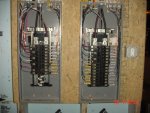This would only apply to any lights on the same circuit as the AC (which there normally would not be).
And using Kirchoff's theory the bus is a node, thus the lights and everything else in the panel are interconnected. All current into the node must equal all current out. There is no restriction or limitation on where that current comes from because there is nothing to stop it in an AC system from flowing in any direction within the confines of the interconnected bus.
Actually, increasing the AC conductors' size would cause more starting-current-induced voltage drop on the conductors that the AC and light share; i.e., ahead of the panel.
Starting current does not induce voltage drop. Voltage drop is a side effect of conductor size. The amount of voltage drop varies solely based on the size of the conductor and it's associated impedance. Because the impedance of the load is fixed, different wire sizes change the measured voltage at the AC unit (in my presented scenarios, the #3 wire would have the highest measured voltage at the AC terminals and the lowest voltage drop). In comparison to different wire sizes, the starting current must change because of Ohm's law.
Reduced starting voltage caused by excess voltage drop on the AC circuit would decrease the effect of voltage drop on the shared service/feeder conductors, reducing flicker.
Yes, that was the first point I was making. I suspect that you are moving past the initial moment without analyzing the initial moment. The training that I received discussed these issues within time constants. Time constants are merely different points in time (in this case I am looking at cycle level time, or 1/60th of a second increments or so).
Initially, the AC contactor is not made, what is system voltage? Constant. At the same time there is a measurable voltage drop at the AC contactor, which does not affect voltage measured at the panel. Voltage drop at the AC contactor is not a part of the discussion I am presenting for the breaker location.
In the next time constant the contactor makes, what is system voltage at the panel? Constant (system voltage is maintained by the Utility prime mover, wherever that may be). System impedance drops causing an increase in current flow. Ohm's law is maintained. The question is where does the current come from? Kirchoff says the node balance must be maintained at the bus. What stops some electrons from flowing out of the lighting circuit upstream (in bus terms) in this particular moment? Are they not closer and easier to be utilized by the new AC load? The additional current flow from the source is not instantaneous. So if some electrons are taken from the lighting circuit (and others), what now happens to power consumption in that circuit? Light flicker, perhaps, while the utility power source is trying to deliver the additional electrons?
I am merely arguing that the theory to locate a large load breaker closer to the power source is sound, and at the same time has a minimal effect at best.
The best solution to minimize light flicker from an AC unit is to over size the circuit conductors in the first place.


